

| Systems Analysis work is like wiping your ass with
a comb. You never get it all the first time... or the second... or the third...or... |
D. Vautier
4/1/2022
 The title to this article is
automatically associated
with the computer industry but in this discussion I define the term
quite differently and more comprehensively.
The title to this article is
automatically associated
with the computer industry but in this discussion I define the term
quite differently and more comprehensively.
One would think systems analysis is the somewhat foggy and mystical study of computer systems and that would certainly be expected, but not here. I don't get involved in any of that stuff like flow diagrams and Gantt charts and critical path descriptions.
More widely speaking a system is anything with moving parts that interact or influence
other parts performing the
 same
or similar function. Moving parts can be defined as anything that does something,
albeit a chemical catalyst, or a minute flow of electrons in a miniature
circuit, or office paperwork, or a load-bearing structural beam, or a
verbal instruction set, or an enzyme in living cells that cause a
reaction within the cell or outside the cell. These are all moving parts
and they are parts of systems. These
parts are many and sometimes very hard to find or even define,
especially in biological and social worlds.
same
or similar function. Moving parts can be defined as anything that does something,
albeit a chemical catalyst, or a minute flow of electrons in a miniature
circuit, or office paperwork, or a load-bearing structural beam, or a
verbal instruction set, or an enzyme in living cells that cause a
reaction within the cell or outside the cell. These are all moving parts
and they are parts of systems. These
parts are many and sometimes very hard to find or even define,
especially in biological and social worlds.
In my understanding there appears to be three major classes of systems; biological, social and mechanical (which of course includes computers). The biological systems tend to develop pretty much by themselves and seem to do a pretty good job of functioning although we try to tinker around with them to achieve other purpose, rarely successfully. Biological systems are self-replicating networks and tend to follow their own entropy (ware out-ness) sometimes over a very long period.

Social systems are driven by many human factors and by nature can be very complicated and they, of course, break down over time, as explained by the Maximum Entropy Principle (Smith and Erickson, 280). The ME principle states briefly that social or biological systems self-decide the best way to operate but the best way leads to a higher degree of entropy. The ME principle is all pervasive.
Mechanical systems include computer business applications which are actually half social, half mechanical, and the ME principle certainly applies to these big time. But the good news is that entropy can be delayed by opportunistic and skilled human intervention.
 There are three
arrangements of systems I think; hierarchical, linear and network.
A military organization along with many others, supposedly can
try to be
defined as a hierarchy but because it involves human interdependence it
realistically functions as a network. A hierarchy that can break its
rules becomes a network.
There are three
arrangements of systems I think; hierarchical, linear and network.
A military organization along with many others, supposedly can
try to be
defined as a hierarchy but because it involves human interdependence it
realistically functions as a network. A hierarchy that can break its
rules becomes a network.
There are also deterministic and stochastic
systems. The first is one is
rule based whereas the second is not. Deterministic systems evolve through entropy into non-rule
based entities. A good
example of a deterministic hierarchy is a row of dominos set up so the
first domino sets off two more dominos and so forth such that the rule
can’t be broken except by intervention, bad design or some failure. This is a true hierarchy because each part by definition has
one rule, to knock over the two lower parts.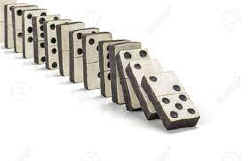
A linear example of a deterministic system is a clock in which the main spring acts upon a successive series of reduction gears that eventually drive a second hand. Each gear again has one function, to drive the downstream gear. A generator is a linear system. Force goes in. Electricity comes out.
Any human organization such as a business, a
religious order, a community or society is by its definition a
network, wherein rules can be and are broken; in fact have to be broken
sometimes in order to continue to function, and reduce entropy, that is,
minimize the ME principle. It
is stochastic in nature which means that it seeks out multiple (optimal)
paths to the same solution and the choice of multiple paths again
attempts to minimize entropy but unfortunately expedites it. Human organizations may claim to be hierarchic and in general try
to act that way but never really succeed. So too, with any social or
biological system, rules can be broken and the network is free to make
or break relationships with other parts in order to keep the system
running at a risk of higher entropy. When you “left hand” a procedure, or you “get it done” or
“expedite” or “know a shortcut”, these are all ways to break
rules and seek out alternate faster and apparently better solutions. The
immune response is a perfect example of a very complex system
constantly changing rules to achieve a goal to protect the organism.
Systems may start out with an attempt to be hierarchic but tend to evolve into networks because rules are bypassed and discarded (based on ME) because conditions always change over time. All social and biological systems are by definition networks.
Mechanical and computer systems may be linear or hierarchical. Mechanical systems are often rule-bound whereas computer systems are a crossbreed of human and mechanical.
Systems analysis is the study to identify and understand what these moving parts are and how they interact with other parts that change over time. We know that all systems ware out. Animals go extinct. Houses get old and get torn down or rot away. Governments die. Civilizations die too. This is called entropy which is simply built into everything. It happens sooner or later but it doesn’t have to happen sooner if we understood how to keep the parts running robustly and anticipate points of failure and respect the ME principle. The main purpose of systems analysis therefore is to slow down or even possibly stop entropy until a replacement can be done. A replacement system will always be needed because all systems ware out.
When I analyze something I like to refer to anything that has an activity within a system as a “node”. A node is a more inclusive definition than “part” or “function” or “activity” or “decision point”. A node can simply be a meeting or joining of forces. I refer to the relationship between nodes as a “force”, a much better word to use because it is less specific for a specific reason. It has directionality and force, at least force the way the system understands, that is, to contribute to the function and operation between nodes. All networks can be described in terms of nodes and forces. Two or more forces act on a node and these create a way to resolve the force into some kind of new force such as a product or result. Many examples of this come to mind. A billing system is created to bill people for services. A village defense system is created to protect a village. Rats develop an immune response to a new virus. These are all systems in various stages of growth or decline. There is no network system response that is complete or finished. Forces and nodes are always changing, and entropy is built into it. When systems are left alone they begin to degrade. Entropy is built into it.
 When
I was developing new systems at Boeing in early 1980 they required a 20
year software lifespan. My gut reaction was that we were using a date
that only carried a two digit year and would have to be redone in 20
years. I felt the estimated
cost to build this in was minimal but nobody cared. Twenty years later the company had to make a huge effort to
correct the “mellenium bug”. This
remains in my mind the clearest example of obvious and avoidable
entropy.
When
I was developing new systems at Boeing in early 1980 they required a 20
year software lifespan. My gut reaction was that we were using a date
that only carried a two digit year and would have to be redone in 20
years. I felt the estimated
cost to build this in was minimal but nobody cared. Twenty years later the company had to make a huge effort to
correct the “mellenium bug”. This
remains in my mind the clearest example of obvious and avoidable
entropy.
The Social Security system was established in 1935
and used unit record card equipment to function. By 1960 there was a huge effort to re-program it to computers
using the latest COBOL language. There
has been no significant effort since that time to maintain the Social
Security monster. Entropy
has taken over. COBOL
programmers became a sought after commodity.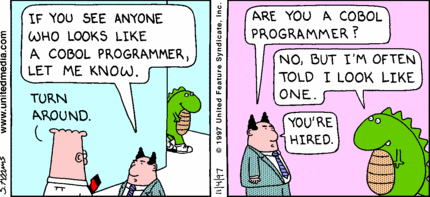
President Lincoln started the IRS in 1862 as an effort to pay for the war. People were paid in dollars or greenbacks or pigs before that time. By WW1 the government had to switch to unit record processing because of the growth and complexity. All kinds of deductions began on payrolls by federal, state, and local governments. Payrolls continued to be handled by card equipment but by 1960 just about everyone switched to computers to process payrolls. Huge opportunities were lost in those days as analysts and programmers rushed to simply transfer the same procedures over into a more efficient environment instead of rethinking and redesigning the systems. The computer programs set up began to degrade. That was 60 years ago. The IRS is backed up probably a few years because they have not properly dealt with entropy.
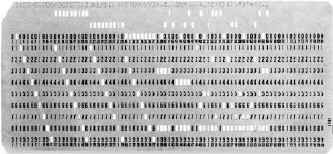 Back
in those days programmers and analysts were said to have 80 column
records burned into the back of their eyeballs because data storage
was restricted to the famous IBM 5080 card that had exactly 80 columns.
Back
in those days programmers and analysts were said to have 80 column
records burned into the back of their eyeballs because data storage
was restricted to the famous IBM 5080 card that had exactly 80 columns.
Internet Explorer was the first internet browser. It was not properly maintained and after several years of use it became a monster of convoluted and confibulated code. Microsoft sent in many of their top programmers to fix it but they were never to be seen again. (That was the joke going around at MST.)
The universe is expanding and dissipating heat (even though the first law of thermodynamics says no but the third law says yes). So the universe presents the supreme example of entropy. In fact the third law suggests the universe will finally obtain zero Kelvin in 22 billion years or so, or try to. I don’t know what will be left because the two fundamental particles of matter, electrons and quarks cease to exist at zero Kelvin so maybe nothing will be left over.

γνῶθι σεαυτόν (knothe seauton) understand yourself (an old Greek saying)
Good systems people are made by training. Great systems people are born. These fortunate people develop strong right brains before they are 10 years old. That is when the corpus callosum develops (Campbell, 241).
Most higher life forms have lots of redundancy built in; two eyes, ears, arms, legs, lungs, kidneys. What about the brain, the most important organ of all. Yes we have redundancy there but not quite the same kind that we would normally expect so we never really understand ourselves. The right brain keeps itself to itself (as the British say). The right brain can’t speak or measure or count or tell time or follow directions or really explain how it works so we spend our whole lives trying to figure ourselves out, maybe consulting psychiatrists and priests and soothsayers and fortune tellers but never getting a real answer or a straight answer. The right brain won’t tell us. We always come up with The Fool card. Who am I? How do I figure things out? But the right brain knows.
So too, information about the world is perceived in different ways by each hemisphere of the brain (Campbell, 240). That's the beauty of it. How these hemispheres communicate depends a lot on how they transfer data. This wiring between them is done with a compact bundle of neurons called the corpus callosum (CC) which starts developing at birth and continues until about age 10. So, believe it or not, great systems analysts develop between the ages of 2 and 10. The ability to deconstruct and construct things actually seems to develop during this period. The ability to see parts and how they interact is very much a right brain activity. The observations of clocks and washing machines and dishwashers and gyroscopes is fundamental in balanced brain development during childhood.

True that handedness (left or right) does influence the right brain in some ways (Edwards, 42), but I’m not suggesting that all system analysts should be south-paws, but I am saying that in any case the poor right brain would be hard pressed to live life or even survive all by itself. (On the other hand, pun intended) the left brain could do so but with great difficulty. But it would have such a boring, meaningless, drab, futile and inconsequential life, a life with no meaning or dreams, or wonder or wild parties or sex.
So what does right brain activity have to do with good systems work? A lot I think. People who are really good at studying systems and taking them apart and putting them back together better I hope, are also strong at both left and right brain activities. Where the left brain sees complexity, the right brain sees simplicity.
Huge volumes of material have been compiled
discussing left/right brain function. All kinds of tests have been done especially in reference to the
corpus callosum (CC), the big neuron connector that communicates between left and right
brain. Rather than dwell on
all this brain theory I can better summarize it with
a table.
|
Left brain |
Right brain |
|
speaks |
listens |
|
Takes things apart |
Puts things together |
|
Uses symbolic things |
Uses actual things |
|
Time and schedules |
No sense of time |
|
rational |
Inspirational, hunches, guesses |
|
Digital, measurable |
Spatial, relational, unmeasurable |
|
logical |
Intuitive |
|
linear |
Holistic * |
|
Bottom up |
Top down |
|
Deterministic |
Stochastic * |
|
Limited |
Unlimited |
|
Explicit |
Implicit |
| Complexity | Simplicity |
Holistic is a concept that the whole is greater than the sum of the parts. It’s kind of like saying 2 plus 2 equals 5 but the right brain can’t do math so to it, 2 and 2 can equal 5. To the right brain when all the parts are evaluated together they become more valuable because parts are able to reinforce each other and, even though they have no quantitative dimension, they are still greater. A clock is just a bunch of wheels, gears, and springs but a functioning clock working properly gives time whereas a broken clock does not. When a payroll system works the way it should people get paid and the government gets paid too so everybody’s happy. Holism sees not just the system but everything connected to it: goodwill, benefits, and minimal entropy. In fact the most valuable aspect of this concept of holism is the ability to reduce or even eliminate entropy. Some people refer to this as robustness. Writing software that is modular, (plug-in-ness), loosely connected, and interchangeable are all aspects of holism. Holism anticipates change. It has change built-in. It sees change before it happens.
 On
one occasion when I was working for Boeing I was assigned to
replace a rather critical computer system controlling what they called
“out-of-sequence” parts. They
had lost the source code. If
you are familiar with information systems, this can become a very serious
issue when source code is lost. I went up to Everett with my manager and looked over the system.
She was obviously upset at the overwhelming complexity of the project and
it showed on her face. I
simply asked a lot of questions and took no notes whatsoever. I was working totally right brain because at that time I saw only
the forest. The trees would
take care of themselves. Afterword I told
her that it would take six months to do the job and they will get a
better product. It took four
months and they got a better product. The company gave me a bunch of rewards but the best reward for me
was getting such an opportunity.
On
one occasion when I was working for Boeing I was assigned to
replace a rather critical computer system controlling what they called
“out-of-sequence” parts. They
had lost the source code. If
you are familiar with information systems, this can become a very serious
issue when source code is lost. I went up to Everett with my manager and looked over the system.
She was obviously upset at the overwhelming complexity of the project and
it showed on her face. I
simply asked a lot of questions and took no notes whatsoever. I was working totally right brain because at that time I saw only
the forest. The trees would
take care of themselves. Afterword I told
her that it would take six months to do the job and they will get a
better product. It took four
months and they got a better product. The company gave me a bunch of rewards but the best reward for me
was getting such an opportunity.

Linear design is focused on bottom-line, results-oriented thinking. It tends to wear out faster because the purpose is to arrive at the finish line in the shortest possible time and at the cheapest cost. Linear thinking is very focused in scope and hard-wired, not table-driven or menu-driven. This approach has been referred to often despairingly as short-term thinking because, as managers scream “Everything is short-term! I have schedules to keep. I have deadlines to meet, I have measurement criteria to satisfy”. Short-term and long-term have nothing to do with holistic design. The right brain has no perception of time. It takes the same amount of “time” to go holistic as to go linear. The results are dramatically different.
There is no top. There is no bottom. These are all artificial constructs found in systems' text books.
When a system is designed or more often redesigned it is usually done from several directions. Node designers start from the bottom, if they can find it, by assembling nodes that perform given elemental functions and then try to fit them together upwards. They can beg, borrow, steel, or design these nodes often according to cost and time constraints. Top down people start from what they think is the highest or most important node and begin building down, fitting nodes together as they go down and determining how internal and external forces interact.
Most systems are networks, so again, where is the top node? Where do the top-down guys start? It’s an arbitrary thing and once a top-downer gets into the workings they soon realize that there is no real top and also no real bottom either but there can be an outside-in and an inside-out.
We are dealing with views. How a system can be viewed depends upon what part of that system you are participating in and working with or assigned to or familiar with. For example with computer systems you have developers who are bottom-up, system users who are top-down and suppliers who are outside-in.
If it is a social system such as a social network, all these rolls are constantly changing. If it’s a biological system the whole thing becomes almost impossible to figure out. the doctors are bottom-up, the patients are outside-in and the medical establishment is top-down.So how can one try to more utilize the right
brain. Many books have been written on this (Edwards, XII), and
again, the best opportunity for right brain development occurs at age 2
to 10. But, nonetheless, I propose the
doddle.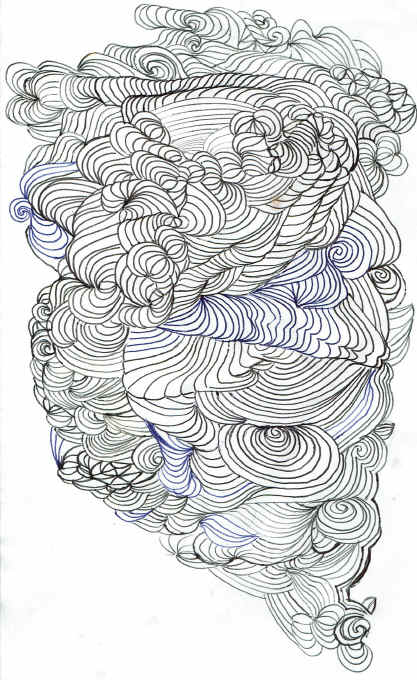
Doodle, dreams and daydream.
When at a staff meeting or lecture the left brain listens but only a very small area of the right brain is even active. Watching TV news amounts to very much the same right brain laziness. Our right brain tends to be lazy because we never pay attention to it. Reading a hot novel drives the right brain wild. Using a cell phone to follow social media is all left brain activity and the right brain simply gets left outside.
But the right brain does take it’s vengeance on this neglect and complete disrespect over time by causing carelessness, forgetfulness, fear, dreamlessness, memory loss, dementia, lack of concentration, boredom, followed by perhaps even other worse dysfunctions. Respect the right brain! The left brain gets exercised all the time every day in our normal life but the poor right brain sometimes just wastes away largely because we don’t exercise it enough and we don’t even know how. Eating, adding numbers, researching, studying is all left brain stuff.
Primitive man lived in a world that recognized the strengths of both sides of the brain, i.e. the full brain. Modern man lives in a world where right brain functions are underutilized.
Music has charms to sooth...
If you are a lover of music then you have a strong right brain, not to say that if you have a tin ear, you are at a disadvantage. Well yes, you are, sort of, like being right-handed. Being able to visualize musical notes and “see” harmony is right brain activity. Being able to catch a melody and pick out and do harmonies with it, either in thirds or fifths above or below the melody is definitely a good right brain exercise. Being able to invent melody, improvise, jam, dance to your own music with imaginary partners is all part of the exercise.
Made to order dreams.
I have tinnitus
and I fall asleep to music. This
music sometimes weaves itself into my dreams. I try to build my own
dreams by arraigning songs that my dreams can respond to. Sometimes my
dreams take me to Harold Hill doing "Trouble in River City" or
Nanki-Poo doing "Wand'ring Minstrel"
So how many faces?
Back in the 60’s when I studied computer systems analysis and when I compare it to the literature of today I find little difference. Of course there are lots of new terms but there has not been much in the way of serious technological breakthroughs except in data sharing and internet. The real difference is in the scope of systems analysis which includes so many more things than it used to.
Systems analysis in the computer world means something vastly different than what I have presented here. It is a discipline immersed in business procedures, objects and components within a business unit (George, 5). To be more specific we start running into unexplainable and often confusing ideas like object oriented code, interfaces, environment, components, modularity, coupling, cohesion, decomposition and a host of other even more confusing terms, terms that have been used since the early tempestuous programming days of the 1960’s.
The struggles in data processing became more acute in the 1990’s when companies were more and more dissatisfied with the amount of good service they were getting out of their DP (data processing) departments so they renamed the whole lot of these guys IS (Information Systems) as if that would fix everything. The struggle continued for decent requirements gathering, good analysis, efficient data base design and robust programming (George, 7), none of which was easily had on any project, at least all at the same time.
My job in this maelstrom was all of the above, which is to say, I was the project manager who listened to users, told them what they needed, how the system was to run, how the data bases were to be designed and what the programmers were to program. I never had a project cancelled or come in late or fall short of specification. My most difficult times were with DBAs (data base administrators) who tend to suffer from collective cases of serious narcissism.
The redeeming concepts of OO (object oriented programming), structured walkthroughs, scaling, conversion planning, prototyping, documentation tools (like the horrible p+) and best-use were around in one form or another since the very beginning on the data processing industry but at least now they had names. That may be a form or progress I suppose.
The idea remains that good computer systems analysts were too busy managing projects to have the time to write about what they were doing.
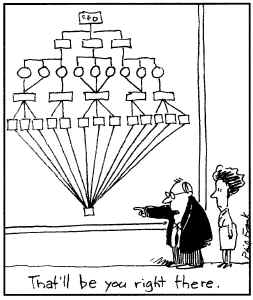
Sources:
Campbell, Jeremy, Grammatical Man, 1982.